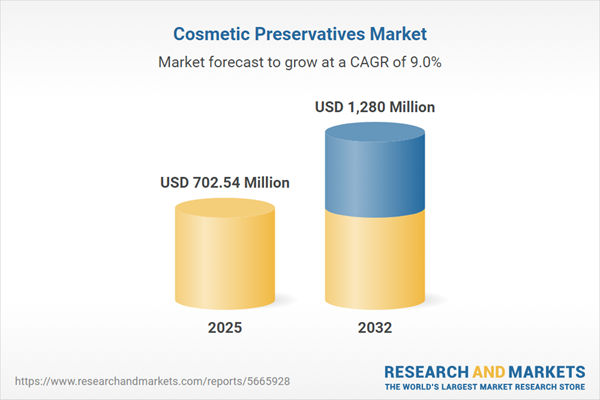Speak directly to the analyst to clarify any post sales queries you may have.
The cosmetic preservatives market is in a period of rapid evolution, driven by increased consumer scrutiny, tightening regulatory environments, and industry innovation in green chemistry and digital formulation tools. Senior decision-makers face a complex landscape where efficacy, compliance, and consumer expectations converge.
Market Snapshot: Cosmetic Preservatives Market Growth and Opportunities
The cosmetic preservatives market grew from USD 645.18 million in 2024 to USD 702.54 million in 2025, and is projected to reach USD 1.28 billion by 2032, expanding at a CAGR of 8.95%. Growth is fueled by rising consumer expectations for cleaner labels, increasing product complexity, and regulatory pressures worldwide. The market's dynamism is apparent across all geographic regions, with adoption reflecting regional trends in regulatory standards and consumer attitudes.
Scope & Segmentation: Comprehensive Market Coverage
- Product Types: Blends, including proprietary and standardized blends; Natural systems, incorporating botanical extracts, essential oils, and organic acids; Synthetic preservatives, such as formaldehyde-releasers, isothiazolinones, parabens, and phenoxyethanol.
- Applications: Color cosmetics (eye makeup, face makeup, lip products); Hair care (conditioners, shampoos, styling products); Oral care; Personal hygiene (deodorants, hand sanitizers); Skin care (anti-aging, cleansers, moisturizers, sunscreens).
- End User Groups: Adults (female and male), infants and children, consumers with sensitive skin.
- Sales Channels: Direct sales, hypermarkets and supermarkets, online retail (brand websites, e-commerce platforms), pharmacies and drugstores, specialty stores.
- Formulation Types: Anhydrous, aqueous, emulsion (oil-in-water, water-in-oil), powder formulations.
- Preservative Chemistry: Formaldehyde-releasers, isothiazolinones, organic acids, parabens, phenoxyethanol.
- Geographies: Americas (North America—including United States, Canada, Mexico—and Latin America), Europe, Middle East & Africa (with detailed regional breakdowns), and Asia-Pacific (including China, India, Japan, Australia, South Korea, Southeast Asia, and others).
Key Takeaways: Strategic Insights for Senior Leaders
- Emerging green chemistry and digital tools are reshaping preservative development, enabling more sustainable and consumer-aligned solutions.
- Shifts in regional regulations require a flexible approach, as standards and expectations diverge across markets.
- Technologies such as blockchain and IoT are enhancing supply chain transparency and traceability in preservative sourcing.
- Formulation complexity and consumer demands for transparency are accelerating innovation in both synthetic and natural preservative blends.
- Market segmentation by application and end user presents opportunities for targeted product innovation, especially for sensitive skin and children’s products.
- Robust risk management—including supplier qualification and stability testing—remains essential to safeguard product integrity and brand reputation.
Tariff Impact: Navigating the Effects of U.S. Trade Policies
The introduction of new United States tariffs on key cosmetic preservative raw materials by 2025 has introduced financial and operational challenges for global supply chains. Increased duties on essential intermediates have triggered a reassessment of sourcing, pricing, and supplier relationships, prompting manufacturers to diversify suppliers or localize production. These actions affect logistics, compliance, and contract structures, underscoring the need for supply chain resilience in a shifting trade environment.
Methodology & Data Sources: Reliable, Mixed-Methods Approach
This market analysis used a robust mixed-methods approach, including primary interviews with industry experts, secondary research from journals and regulatory databases, and comprehensive surveys targeting manufacturers and suppliers. Data triangulation and advanced analytics assured accuracy and relevance, offering a holistic perspective supported by geospatial and scenario-based assessments.
Why This Report Matters: Decision-Making Value for B2B Leaders
- Gain a 360-degree perspective on product, technology, and regional trends facilitating strategic planning.
- Understand regulatory dynamics to reduce risk and seize opportunities specific to segment and application.
- Leverage actionable insights for investment in innovative, compliant, and consumer-focused preservative strategies.
Conclusion: The Path Forward for Cosmetic Preservatives
The cosmetic preservatives market is set for continued transformation as stakeholders navigate evolving regulations, sustainability demands, and technological change. Informed, adaptable strategies will be critical for resilience and future success.
Additional Product Information:
- Purchase of this report includes 1 year online access with quarterly updates.
- This report can be updated on request. Please contact our Customer Experience team using the Ask a Question widget on our website.
Table of Contents
3. Executive Summary
4. Market Overview
7. Cumulative Impact of Artificial Intelligence 2025
List of Figures
Samples

LOADING...
Companies Mentioned
The key companies profiled in this Cosmetic Preservatives market report include:- BASF SE
- Lonza Group AG
- Dow Inc.
- Clariant AG
- Ashland Global Holdings Inc.
- Solvay SA
- Evonik Industries AG
- LANXESS AG
- Merck KGaA
- Schülke & Mayr GmbH
Table Information
| Report Attribute | Details |
|---|---|
| No. of Pages | 191 |
| Published | October 2025 |
| Forecast Period | 2025 - 2032 |
| Estimated Market Value ( USD | $ 702.54 Million |
| Forecasted Market Value ( USD | $ 1280 Million |
| Compound Annual Growth Rate | 8.9% |
| Regions Covered | Global |
| No. of Companies Mentioned | 11 |









